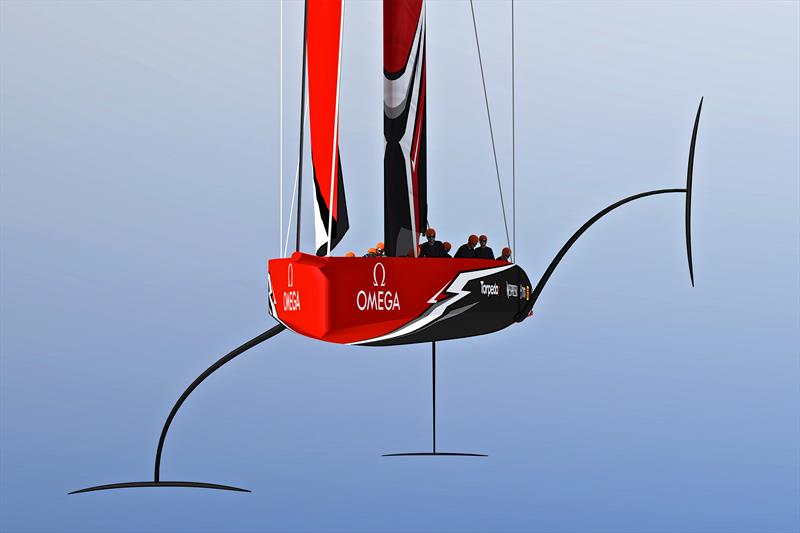
America's Cup: Amended AC75 class rule released
by Richard Gladwell, Sail-World.com/nz 29 Jun 2018 22:39 HKT
30 June 2018

The new AC75 class will feature supplied and one design features © America's Cup Media
The Royal New Zealand Yacht Squadron and Circolo della Vela Sicilia, together with their respective teams Emirates Team New Zealand and the Challenger of Record - Luna Rossa, have published an updated AC75 Class Rule for the 36th America's Cup Friday (NZT).
The AC75 Class Rule defines the parameters within which teams can design a yacht eligible to compete in the 36th America's Cup.
While a schedule of changes has not been provided, the changes in several key areas appear to lower the potential cost of AC75's, specify some key changes and make the class rule more well defined and elegant with less need to refer to the Measurement Committee for interpretation.
A change that does not appear to have been made is the allowance of modification of both AC75 hull's built by a team - which was flagged in the first version as an option being considered by the Challenger of Record and Defender (COR/D).
Currently, only one AC75 hull surface can be altered by up to 25% of its original surface area, once the boat has been launched and measured. That limits the team to either modifying their first launched AC75 to get the hull shape etc right, and then designing a second AC75 based on that experience. Or not altering the first launched and the using the second AC75 as the "Lego" boat. Most would probably run the former model. However, allowing the modification of only one hull does make the regatta more even for the teams which have built only one hull.
A point of clarification has been introduced where the Rule now talks about Foil Arm Stocks and then the more complex of Foil Wing and Foil Flaps. The weight of the Foil Arm Stock (a one-design supplied part) is set at 245kg while the Foil Wing and Flaps are at 970kgs. The latter component and fairings that attach to the Foil Arm are designed and constructed by each team for their boat(s).
The Rule which only allowed listed paint finishes by name has been simplified - with a lesser numbers of off the shelf products being listed, but with an application procedure to add more.
A new section has been inserted which takes the concept further and requires several composite construction products to also be commercially and readily available for example the hull core materials and resins must "be available for purchase by all Competitors at a reasonable market price"; have a lead time to delivery of nor more than six months; and not have been developed specifically for a competitor or group of competitors - unless this was done prior to March 31, 2018.
So there is no point in forming a partnership with an aircraft or spacecraft manufacturer to use specially developed construction materials unless these are available to all teams and comply with some other tests as to availability.
The restrictions previously in place for paints, have now been expanded to include all surface finishes - clearing up a potential loophole, and clearly aimed at reducing the scope for expensive, one-off drag reduction coatings.
An total weight of major listed components has been increased by 100kg overall so that the hull, sails, foils, rigging and crew must weigh within a tight range of 7570-7600kgs. The change appears to have arisen from an assessment of more detailed weights of the component, with the unders and overs totalling 100kg. The weight of the crew remains in the 960-990 range or a 90kg average weight - up just 3kg from the AC50 average crew weight. The low crew weight will open up the options for lighter crew members in some roles in order to lift the weight of the grinding team and those involved in the pit of the boat.
The specific weight list excludes several components of which the mast and mainsail are two. They are expected to be added to the weight schedule once the drawings and specifications are complete in two months time. The new "sailing weight" of 7570-7600kgs includes the spars, sails and all components.
Other changes include a re-write of the mast rule to clarify construction with plans to be supplied by August 31, 2018. The changes appear to be aimed at closing loopholes in the earlier version of the rules. The fundamental concept of the D-shaped mast with two mainsail skins attached to its aft edge is unchanged.
The Rules are incomplete, with a further 15 items to be provided/defined according to a timeline with specific dates against those items in the latest version of the Rule, where those items were just noted and open dated in the first version issued on March 29, 2018.
Download a copy of the new AC75 class rule here.